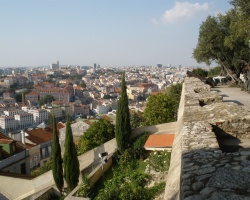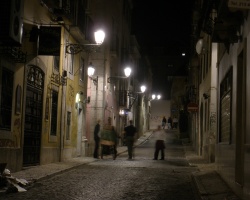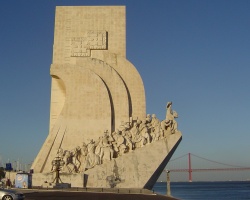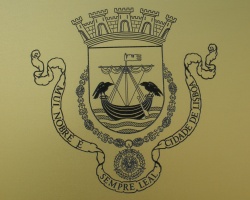Have you ever wondered why the raven is the mascot of the city of Lisbon? What are the seven hills of the city? Who are all the figures that appear in the Monument of the Discoveries? These and other curiosities were unveiled by the reporters Joana Simões Piedade and Tiago Pais, which read books, researched archives and consulted historians to obtain the answers.
What are the seven hills of Lisbon?

Lisbon seen from the Castelo de São Jorge | BestInPortugal.com
Lisbon is known as “cidade das sete Colinas” (city of the seven hills). This nickname appeared for the first time in the book of the magnitudes of Lisbon, by friar Nicolau de Oliveira in the seventeenth century. The author wanted to force similarities with Rome, claimed to be also built on seven hills (Aventinus, Caelius, Capitolinus, Esquilinus, Palatinus, Quirinalis and Viminalis). Upon arriving to the city by boat, he named the seven hills on which Lisbon was edified:
- São Jorge : Where the castle which bears the name is located.
- São Vicente : Where the São Vincente de Fora Monastery and the Alfama area are located.
- Sant’Ana : Between the Martim Moniz square and the Rua Portas de Santo Antão, which contains the São José Hospital.
- Santo André : The peak of this hill is Largo / Miradouro da Graça.
- Chagas : At the Largo do Carmo
- Santa Catarina : In the Bairro Alto, close to Largo Camões
- São Roque : Also in the Bairro Alto, around the Miradouro de São Pedro de Alcântara.
Curiously, the colina da Graça (Graça Hill), which is the tallest of them all, was not included in the friar’s list. Maybe because upon his arrival by sea, Graça appeared covered by the hill adjoining the castle. Talking with impartiality, this idea of the 7 hills is stretching the truth to an extreme. The historian Damião de Góis, in his rigor, could only identify four or five of them.
Did you know that the kings of Portugal lived in a hut for various years?
Don’t fret, since it wasn’t a crude mud hut: it was the Royal hut – a palace in wood and fabric, ordered by Dom José on the hills of Ajuda, in Lisbon after the 1755 earthquake. It was built to resist new tremors, and ended up consumed by a fire in 1792. In its place the Palácio Real da Ajuda (Royal Palace of Ajuda) was erected.
Do you know what was the most affluent neighborhood in Lisbon in the sixteenth century?

Bairro Alto at Night | BestInPortugal.com
Bairro Alto became the richest neighborhood in town. Back then, Lisbon was expanding at full speed reaching almost 200.000 inhabitants. Bairro Alto was erected, at first known as Vila Nova dos Andrades, in honor of rich bourgeois of the Spanish Galicia Province which settled there.
Did you know that the Cristo-Rei monument (Sanctuary of Christ the King) is not the only copy of a Brazilian statue?
Also the statue of the Portuguese navigator that discovered Brazil, Pedro Álvares Cabral, is exactly the same as one that exists in Rio de Janeiro, created by Rodolfo Bernardelli and inaugurated in 1941. The Portuguese statue was offered to the Portuguese government by the Brazilian government.
Lisbon is a very peaceful city. Was it always this way?
Apart from the 1755 earthquake, the other catastrophe that befell the city was the massacre of 1506 in which an angry mob of religious fanatics chased, raped, tortured and murdered between two and four thousand people accused of being jews.
Who are the historic figures on the Padrão dos Descobrimentos monument?
The Padrão dos Descobrimentos (“Monument to the Discoveries) celebrates the Portuguese who took part in the Age of Discovery, of the 15th and 16th centuries, and includes 33 featured personalities, which are:

Padrão dos Descobrimentos monument | BestInPortugal.com
- Infante Pedro, Duke of Coimbra (son of King John I of Portugal)
- Queen Philippa of Lancaster
- Fernão Mendes Pinto (explorer and writer)
- Friar Gonçalo de Carvalho (Dominican order)
- Friar Henrique Carvalho (Franciscan order)
- Luís de Camões (renaissance poet who celebrated the navigations in the epic Lusiads)
- Nuno Gonçalves (painter)
- Gomes Eanes de Zurara (chronicler)
- Pêro da Covilhã (traveller)
- Jácome de Maiorca (cosmographer)
- Pedro Escobar (navigator)
- Pedro Nunes (mathematician)
- Pêro de Alenquer (navigator)
- Gil Eanes (navigator)
- João Gonçalves Zarco (navigator)
- Infante Fernando, the Saint Prince (son of King John I of Portugal)
- Henry the Navigator (sponsor of the Age of Discovery), which appears at the tip of the monument
- Afonso V of Portugal
- Vasco da Gama (discoverer of the sea route to India)
- Afonso Gonçalves Baldaia (navigator)
- Pedro Álvares Cabral (discoverer of Brazil)
- Ferdinand Magellan (first man to circumnavigate the globe)
- Nicolau Coelho (navigator)
- Gaspar Corte-Real (navigator)
- Martim Afonso de Sousa (navigator)
- João de Barros (writer)
- Estêvão da Gama (sea captain)
- Bartolomeu Dias (first man to cross over the Cape of Good Hope)
- Diogo Cão (first man to arrive to the Congo river)
- António Abreu (navigator)
- Afonso de Albuquerque (second viceroy of Portuguese India)
- São Francisco Xavier (missionary)
- Cristóvão da Gama (captain)
How many species of animals are there is Lisbon?
Not counting those in the zoo, there are 120 species of animals that live in the city. Of these, 50 species live exclusively in the Monsanto Forest Park.
Would you be able to guess how many football/soccer clubs are there in Lisbon?
Throughout the city there are 214 clubs registered in the Football/Soccer Association of Lisbon. Between the Andorinha Futebol Clube and the Clube de Futebol Os Torpedos, not to mention the premier league clubs like Sporting and Benfica, there is a varied choice provided.
Did you know that the Avenida da Liberdade (“Liberty Avenue”) was once a tolled avenue?
The Avenida de Liberdade was once a Promenade. After the 1755 earthquake, the Marquis of Pombal created this promenade in the zone presently situated in the lower Avenida da Liberdade and the Praça dos Restauradores. Despite its name alluding to something that is for all, the fact is that to so called Promenade was surrounded by walls and gates through which only those who paid a tax had access. In 1821 when the Liberals took the power in Portugal, the walls were pulled down and the seclusive promenade was made public.
Do you know why the raven is the symbol of the city of Lisbon?

Coat of Arms of the Municipality of Lisbon by BestInPortugal.com
According to the legend, the two vigilant ravens contained in the coat of arms of Lisbon represent the ravens that accompanied the remains of the patron saint of Lisbon, São Vicente (“Saint Vincent of Saragossa”) during the trip from Sagres to Lisbon. The body of São Vicente, the deacon of Saragossa, martyrized in Valencia during the persecutions of the Emperor Diocletian in the year 303, was brought to Sagres where it remained until 1173. King Afonso Henriques had the body of the saint exhumed in 1173 and brought by ship to Lisbon.
For a long time there was a cult for ravens in the city. The Municipality even had a large cage with ravens in the São Jorge Castle. But gradually the birds started to disappear in Lisbon and today they can only be found in the coat of arms of the municipality.
Article written by Joana Simões Piedade and Tiago Pais which originally appeared in the Time Out Lisboa Magazine and translated under permission by BestInPortugal. Photos by BestInPortugal.com

{ 1 trackback }